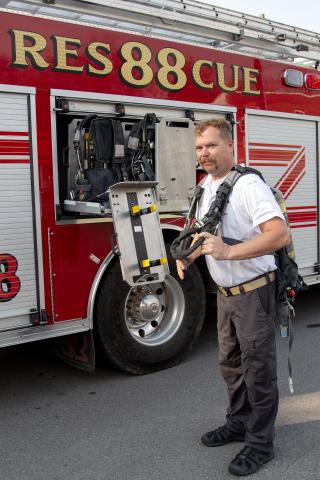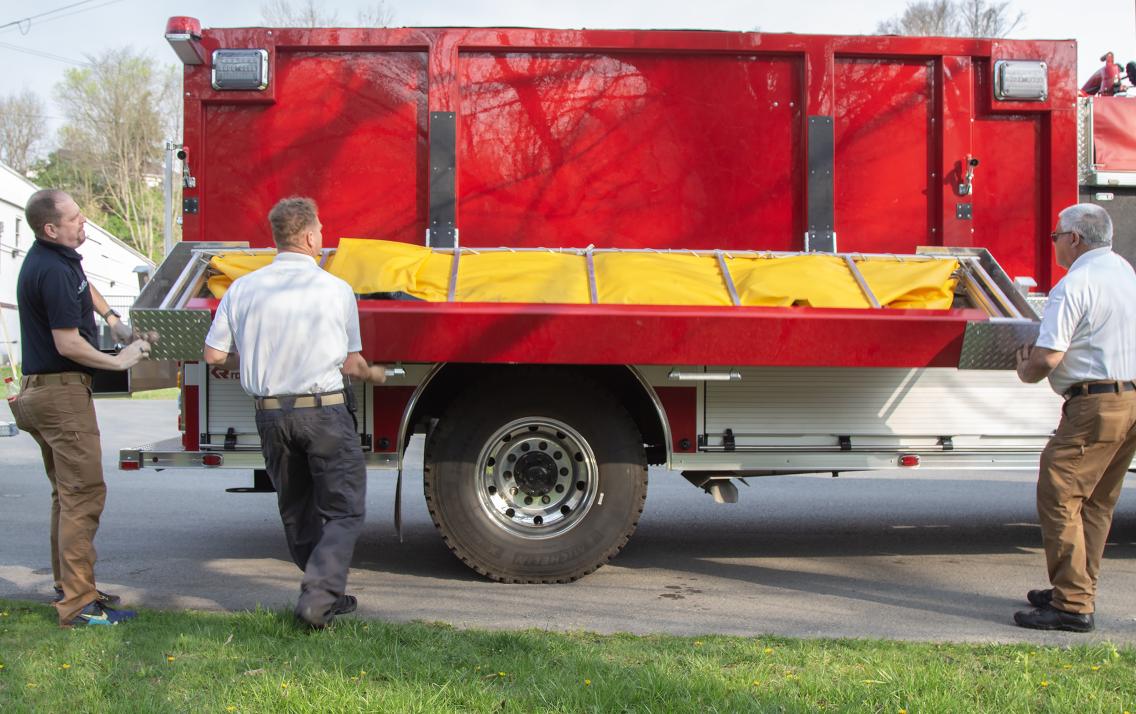
If you think larger, more well-funded communities have cornered the market on public safety innovations, think again. The St. Paul Volunteer Fire Department has built a robust organization with the vision and resources to go well beyond the town’s 1.4 square mile land area.
The certified first response agency covers Wise and Russell counties and supports double dispatch of firefighters or police with Emergency Medical Services (EMS) for calls in Sandy Ridge, Coeburn, Copper Creek, Cleveland, Dante and Castlewood.

While connectivity can be an issue in a place known as the local hub for all things outdoors, firefighters can usually pick up Wi-Fi or create a hot spot by phone to overcome those limitations in some of the most remote parts of Southwest Virginia.
“We have software that can flag houses and hydrant locations to streamline responses,” said Wesley Lawson, a St. Paul firefighter and Emergency Medical Technician (EMT) Intermediate. “Connecting to a hydrant in town eliminates the need for six trucks shuttling water.”
When aging vehicles started to impact the department’s ability to provide timely responses, Town Manager Chad Monday turned to USDA Rural Development (RD) for assistance in securing replacements. Funds provided through the Community Facilities Direct Loan and Grant Program in 2017 helped them secure Rescue 88 to replace a 1997 engine that is now in reserve status.
The department’s 1987 model pumper didn’t fare as well and needed to be taken out of service six years later because the electric over hydraulic braking system was costly to repair, and parts were no longer available. USDA RD stepped in again with a direct loan of $386,000 to finance the purchase of Tanker 88.
“We closed on the new truck (Tanker 88) in November 2023 and took it out on the first call about 12 hours after we got it,” said Monday. “This was my first purchase using USDA RD funds and the local staff made the process as easy as possible.
“It’s a diverse piece of equipment that tackles many of the challenges of rural firefighting and gets put into service frequently. We get a lot of requests from local agencies due to its large water supply, additional hoses, and Type 1 Fire Engine capabilities.”
Around 25 volunteers are now certified to drive the trucks and a town crew of about 10 helps pulls hose and provides manpower for responses. Each vehicle carries 900 feet of 5 inch hose to move more water (3.5 is standard), and Rescue 88 has state-of-the-art extrication equipment.

The team uses a cascade system to fill up to 25 Self-Contained Breathing Apparatus (SCBA) bottles in the field and sometimes goes to other areas to assist with refills.
The high tech touches don’t end there though. The St. Paul crew flew drone flights to monitor fire lines in the forests of Copper Creek and more recently used Tanker 88 to help the Virginia Department of Forestry contain a brush/forest fire in Dickenson County.
They have also mounted a flatscreen monitor on a hitch for large-scale responses or searches. Team members in the fire hall can check road closures and monitor responses on a big screen television, even pulling up blueprints and response plans for some buildings.
“Volunteers and responders were actually able to watch drone flights for a missing Honaker youth in the field,” said Lawson. “We have supported more law enforcement missions than searches.”
Chief Earl Carter focuses heavily on professional development to maintain a high standard of readiness, offering Tanker 88 to teach Basic Pump Operations and Driver Pump Operator courses to firefighters in surrounding Southwest Virginia communities.
St. Paul’s affiliation with the National Association of Emergency Medical Technicians Training Center also enables the department to offer classes and issue certification cards. Nine individuals recently participated in a project to increase the numbers of trained first responders available to serve in the area.
“It’s kind of unusual for a fire department without EMS to have that affiliation, but I’m proud of it,” said Carter. “We offer 27 different courses and actually teach more EMS than fire programs.”
The town's long-term plan is to secure additional funding for construction of a new Public Safety Building to house police, fire, and emergency medical services for the local and surrounding communities. The goal of this project is to create a generational facility for future use that addresses the current and anticipated needs of all involved departments
Whatever the future holds for this small department, they continue to demonstrate a big commitment to performing with excellence and serving at every opportunity.


